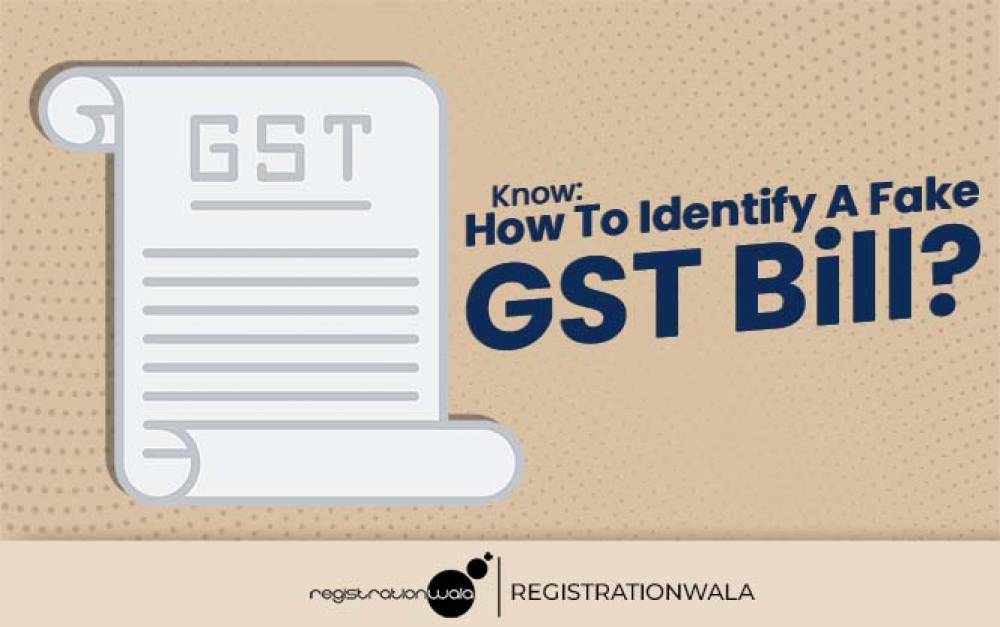How to Identify a Fake GST Bill
- December 05, 2023
- Registrationwala

- Home
- /
- Knowledge Base
- /
- News & other businesses
- /
- Blog
- /
- How to Identify a Fake GST Bill
How to Identify a Fake GST Bill
On June 16th, 2023 the government warned the businesses that are generating fake GST invoices, saying the tax officers would take strict actions in such cases. Union Finance Minister Nirmala Sitharaman chaired the meeting to explain the objectives of the special drive to weed out the fake entities in GST.
In the meeting, the point about strengthing the registration process was delivered to stop the entry of fake entities into the GST ecosystem. Also, the finance minister put points against fake billing for GST evasion. Around 11,140 fake GST registrations have been detected and actions have been initiated against them.
The motive behind the meeting is to ensure that honest taxpayers do not suffer and the government will not lose the revenues. A new return scrutiny system has already been introduced to prioritise cases with higher revenue to get the attention of tax officers. Also, the firms that have an annual turnover of Rs. 5 crores have to file e-invoicing mandatorily.
What Factors in GST Bill to Check Its Originality?
While paying the GST bill, people often do not look at the charges that are added to a bill. Many businesses take advantage of this and do not register themselves legally with the government. But in some cases when customer demand a bill, the business generates a fake bill. If the customer is not aware of how to check the correct GST invoice, then it can lead to issues like tax evasion, and money laundering.
Below are the points that must be mentioned in a bill, if any important information is missing from the invoice then it means that the invoice is fake.
Not Mentioned GSTIN Number
It is a 15-digit identification number assigned to every taxpayer, especially dealer, supplier or any business entity). Before the GST was introduced, all the dealers registered under the state VAT law were issued a unique identification number. However, after the GST law was implemented, having a GSTIN number is compulsory. If a trader issues a GST invoice/ bill without the GSTIN (Goods and Services Tax Identification Number) then an invoice will be considered fake.
Mentioned Fake GSTIN Number
After the GST registration, the business gets an authorised number. But in some cases, the not registered business uses the wrong GST number and unaware people pay the extra to a fake bill. To identify the correct number, you can check its format.
It is a 15-digit number with the state code's first two digits. So, must be aware of your state code, for instance- the code of Delhi is 07. The next 10 digits are the PAN card number, the thirteen digit is the entity number of the same PAN holder in a state, the fourteen digits is the alphabet ‘Z’ by default and the fifteen digits is used to check errors and denote by either a number or checksum digit. You can check the number by looking at the basic features.
How to Check the Right GST Bill?
There is another option as well to check the authenticity of the number and it is through a government portal. Through the GST portal, you can check the number in just these steps. Home > Search Taxpayer > Search by GSTIN/UIN. Enter the GSTIN number mentioned on the invoice, if the number is correct then it will show the other details of the business. But in case the number is wrong it will show a message to change the number. The following details will appear if the GSTIN number is correct:
- Legal and trade name of the business
- Effective date of registration
- GSTIN/ UIN status
- Administrative Office, Other Office
- Principal place of business
- Name of core business activity
- Dealing in goods and services
What are the Reasons to Create a Fake GST Bill?
Some businesses create fake GST bills without legal registration with the authority.
Tax Evasion
As per the PIB press release, from April 2020 to September 2023 more than 6000 fake ITC cases involving more than Rs. 57,000 crore GST evasion cases. To tackle these issues, the DGGI develops intelligence, especially in new areas of tax evasion through advanced tools for data analytics. In the Financial Year 2023-24, a total of 1.36 lakh crore has been detected as overall GST evasion.
Money Laundering
In money laundering the sources of the illegal proceeds are shown as legal and legitimate. This scam is a victimless crime which does not target individuals. The source of the money can be anything such as arms trafficking, drug trafficking, or smuggling and one of the reasons is GST scams.
Basically, the process of money laundering has three steps placement, layering, and integration. In the first step, money is placed into a legitimate financial system. Second the concealing of money through a series of transfers and bookkeeping tricks. In the last step, the laundered money is withdrawn into a legitimate account for criminal activities.
Conclusion
To conclude, the government has strict the rules of GST enrollment method under GST law, to stop the increase of bogus cases. The fake businesses are running different dummy firms, obtaining GST registration and issuing fake GST invoices for goods and services excluding the supply of products. To stop fake GST registration, the government is taking necessary steps. As an individual, you can check the business registration number, and complain about them if they are using fake numbers.
If you are a business owner and want to apply for GST registration, then reach out to Registrationwala. We assist you with documentation to finally obtain the GST certificate.
- 1359 views
